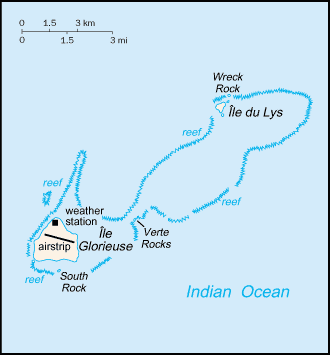|
동부
아프리카에 있는 프랑스령
섬 (1892년부터) 이며, 마다카스카르
(5R) 섬의 북동쪽에 위치하고
있으며 Comoros
(D6) 와 Agalega & St. Brandon
(3B6) 사이에 있다.
기상관측소가
있으며 현지인은 없고 가끔씩
프랑스군인과 과학자들이
머물고 간다. <HL1XP>

Glorioso
Archipelago :
The
Glorioso Archipelago
(7 km? consists
of two coral islands:
Grande Glorieuse
(3 km in its larger
diameter) where
the human installations
are, and Ile du
Lys (circular island,
600 metres in diameter)
which is desert.
The archipelago
also includes two
rock islets - Roches
Vertes and l묲le
aux Crabes - as
well as a sand bank
more or less above
water at high tide.
At the East and
North east of Grande
Glorieuse are a
series of dunes
reaching a maximum
elevation of 12
m. The islands and
rocks are surrounded
by a reef and a
lagoon which is
drained dry at low
tide. The Glorioso
islands are situated
220km North West
of Diego Suarez
(Madagascar). (Economic
Exclusive Zone:
48 350 km?
The
island became French
territory in 1930.
Around 1912, a French
came from the Comoros
and planted there
a fine coconut palm
plantation. Exploited
until 1958 by people
from the Seychelles,
it is currently
abandoned. There
are also filaos.
Fauna consists exclusively
of a rather large
colony of terns.
The
meteorological service
of the French colony
in Madagascar installed
on the island a
rather primitive
weather station
in 1955, which was
opened only during
the hurricane season
from October to
April. Since 1960
the the station
is open all year
round. The importance
of this station
is clear. It predicts
cyclones for the
North Madagascar
and Comoros area.
It ensures safe
navigation on the
Madagascar-Djibouti-Madagascar
and Kenya-Mauritius-Kenya
air and maritime
routes.
|